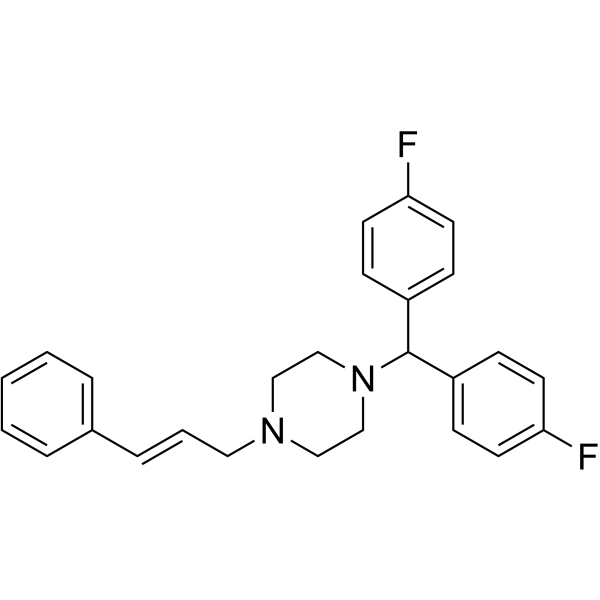
| 规格 | 价格 | 库存 | 数量 |
|---|---|---|---|
| 50mg |
|
||
| Other Sizes |
|
| 靶点 |
Na+/Ca2+ channel (T-type); D2 dopamine receptor
|
|---|---|
| 体外研究 (In Vitro) |
在已生长的大鼠皮质神经元中,flunarizine 可抑制钠电流 (INa) 和钙电流 (ICa),IC50 值分别为 0.94 μM 和 1.77 μM [2]。对于嗜铬细胞,氟桂利嗪(10 和 30 μM;24 小时)会产生细胞毒性作用 [4]。在浓度为 3–10 μM 时,氟桂利嗪 (1–30 μM) 可以显着保护嗜铬细胞免受损伤 [4]。
|
| 体内研究 (In Vivo) |
给予氟桂利嗪(腹膜内注射;30 mg/kg;一次)的小鼠可以免受脂多糖(LPS)引起的急性肺损伤(ALI)[5]。
虽然氟桂利嗪(FLN)已被广泛用于偏头痛预防并取得了明显的成功,但其在偏头痛预防中的作用机制尚不完全清楚。偏头痛是一种通道病,电压门控的Na(+)和Ca(2+)通道的异常活动可能是诱发偏头痛的皮质高兴奋性的潜在机制。本研究旨在探讨FLN对培养大鼠皮质神经元Na(+)和Ca(2+)通道的影响。采用全细胞膜片钳法监测培养大鼠皮质神经元的钠电流(I(Na))和钙电流(I(Ca))。FLN对I(Na)和I(Ca)均呈浓度依赖性阻断,IC(50)值分别为0.94μM和1.77μM。在去极化保持电位越高时,I(Na)的阻断作用越强。FLN使I(Na)稳态失活曲线向超极化电位方向移动。FLN显著延缓了I(Na)快速失活后的恢复。此外,在较高的通道激活率下,FLN阻断I(Na)的作用增强。阻断这些电流可能有助于解释FLN对偏头痛发作的预防作用的机制。[2] |
| 酶活实验 |
氟桂利嗪明显抑制顺铂诱导的细胞凋亡。出乎意料的是,氟桂利嗪增加了HEI-OC1细胞内钙([Ca2+]i)水平。然而,氟桂利嗪对顺铂的保护作用不是通过调节细胞内钙水平介导的。顺铂治疗导致HEI-OC1细胞ROS生成和脂质过氧化。氟桂利嗪不减弱ROS的产生,但抑制顺铂处理细胞的脂质过氧化和线粒体通透性转变。这一结果提示氟桂利嗪对顺铂诱导的细胞毒性的保护机制与直接抑制脂质过氧化和线粒体通透性转变有关[1]。
|
| 细胞实验 |
细胞毒性测定[4]
细胞类型:嗜铬细胞[4] 测试浓度: 10 和 30 μM 孵育时间:24小时 实验结果:证明在10μM浓度下细胞死亡增加的趋势,在10μM浓度下细胞损失接近100%浓度为30μM。 |
| 动物实验 |
Animal/Disease Models: lipopolysaccharide-induced acute lung injury in male balb/c (Bagg ALBino) mouse (6-8 weeks old) [5]
Doses: 30 mg/kg Route of Administration: intraperitoneal (ip) injection; 30 mg/kg; Experimental Results:Inhibition of LPS-induced Cell influx, protein leakage, and inflammatory cytokine release. Suppress lung inflammation. |
| 药代性质 (ADME/PK) |
Absorption, Distribution and Excretion
85% following oral administration. Metabolism / Metabolites Hepatic, to two metabolites via N-dealylation and hydroxylation. Flunarizine has known human metabolites that include 1-[bis(4-fluorophenyl)methyl]piperazine, bis(4-fluorophenyl)methanone, and p-Hydroxyflunarizine. Biological Half-Life 18 days |
| 毒性/毒理 (Toxicokinetics/TK) |
Effects During Pregnancy and Lactation
◉ Summary of Use during Lactation Flunarizine is not approved for marketing in the United States by the U.S. Food and Drug Administration, but is available in other countries. No information is available on the use of flunarizine during breastfeeding. Because of its long half-life of 19 days in children, expert opinion recommends that flunarizine not be used in migraine prophylaxis in nursing mothers. An alternate drug is preferred, especially while nursing a newborn or preterm infant. ◉ Effects in Breastfed Infants Relevant published information was not found as of the revision date. ◉ Effects on Lactation and Breastmilk Relevant published information was not found as of the revision date. Protein Binding 99% bound to plasma proteins |
| 参考文献 |
|
| 其他信息 |
Flunarizine is a diarylmethane.
Flunarizine is a selective calcium entry blocker with calmodulin binding properties and histamine H1 blocking activity. It is effective in the prophylaxis of migraine, occlusive peripheral vascular disease, vertigo of central and peripheral origin, and as an adjuvant in the therapy of epilepsy. Flunarizine is a selective calcium entry blocker with calmodulin binding properties and histamine H1 blocking activity. It is effective in the prophylaxis of migraine, occlusive peripheral vascular disease, vertigo of central and peripheral origin, and as an adjuvant in the therapy of epilepsy. Drug Indication Used in the prophylaxis of migraine, occlusive peripheral vascular disease, vertigo of central and peripheral origin, and as an adjuvant in the therapy of epilepsy. Mechanism of Action Flunarizine inhibits the influx of extracellular calcium through myocardial and vascular membrane pores by physically plugging the channel. The decrease in intracellular calcium inhibits the contractile processes of smooth muscle cells, causing dilation of the coronary and systemic arteries, increased oxygen delivery to the myocardial tissue, decreased total peripheral resistance, decreased systemic blood pressure, and decreased afterload. Pharmacodynamics Flunarizine is a selective calcium entry blocker with calmodulin binding properties and histamine H1 blocking activity. |
| 分子式 |
C26H26N2F2
|
|---|---|
| 分子量 |
404.49484
|
| 精确质量 |
404.206
|
| 元素分析 |
C, 59.40; H, 4.65; F, 6.26; N, 13.85; O, 15.83
|
| CAS号 |
52468-60-7
|
| 相关CAS号 |
Flunarizine dihydrochloride;30484-77-6
|
| PubChem CID |
941361
|
| 外观&性状 |
White to off-white solid powder
|
| 密度 |
1.17 g/cm3
|
| 沸点 |
511.3ºC at 760 mmHg
|
| 折射率 |
1.606
|
| LogP |
5.261
|
| tPSA |
6.48
|
| 氢键供体(HBD)数目 |
0
|
| 氢键受体(HBA)数目 |
4
|
| 可旋转键数目(RBC) |
6
|
| 重原子数目 |
30
|
| 分子复杂度/Complexity |
487
|
| 定义原子立体中心数目 |
0
|
| SMILES |
C1CN(CCN1C/C=C/C2=CC=CC=C2)C(C3=CC=C(C=C3)F)C4=CC=C(C=C4)F
|
| InChi Key |
SMANXXCATUTDDT-QPJJXVBHSA-N
|
| InChi Code |
InChI=1S/C26H26F2N2/c27-24-12-8-22(9-13-24)26(23-10-14-25(28)15-11-23)30-19-17-29(18-20-30)16-4-7-21-5-2-1-3-6-21/h1-15,26H,16-20H2/b7-4+
|
| 化学名 |
1-[bis(4-fluorophenyl)methyl]-4-[(E)-3-phenylprop-2-enyl]piperazine
|
| 别名 |
Sibelium; 1-(Bis(4-fluorophenyl)methyl)-4-cinnamylpiperazine; Flunarizinum; Flunarizina; Flunarizinum [INN-Latin]; Flunarizina [INN-Spanish];
|
| HS Tariff Code |
2934.99.9001
|
| 存储方式 |
Powder -20°C 3 years 4°C 2 years In solvent -80°C 6 months -20°C 1 month |
| 运输条件 |
Room temperature (This product is stable at ambient temperature for a few days during ordinary shipping and time spent in Customs)
|
| 溶解度 (体外实验) |
DMSO : ~100 mg/mL (~247.22 mM)
|
|---|---|
| 溶解度 (体内实验) |
配方 1 中的溶解度: ≥ 2.5 mg/mL (6.18 mM) (饱和度未知) in 10% DMSO + 40% PEG300 + 5% Tween80 + 45% Saline (这些助溶剂从左到右依次添加,逐一添加), 澄清溶液。
例如,若需制备1 mL的工作液,可将100 μL 25.0 mg/mL澄清DMSO储备液加入到400 μL PEG300中,混匀;然后向上述溶液中加入50 μL Tween-80,混匀;加入450 μL生理盐水定容至1 mL。 *生理盐水的制备:将 0.9 g 氯化钠溶解在 100 mL ddH₂O中,得到澄清溶液。 配方 2 中的溶解度: ≥ 2.5 mg/mL (6.18 mM) (饱和度未知) in 10% DMSO + 90% Corn Oil (这些助溶剂从左到右依次添加,逐一添加), 澄清溶液。 例如,若需制备1 mL的工作液,可将 100 μL 25.0 mg/mL 澄清 DMSO 储备液加入到 900 μL 玉米油中并混合均匀。 请根据您的实验动物和给药方式选择适当的溶解配方/方案: 1、请先配制澄清的储备液(如:用DMSO配置50 或 100 mg/mL母液(储备液)); 2、取适量母液,按从左到右的顺序依次添加助溶剂,澄清后再加入下一助溶剂。以 下列配方为例说明 (注意此配方只用于说明,并不一定代表此产品 的实际溶解配方): 10% DMSO → 40% PEG300 → 5% Tween-80 → 45% ddH2O (或 saline); 假设最终工作液的体积为 1 mL, 浓度为5 mg/mL: 取 100 μL 50 mg/mL 的澄清 DMSO 储备液加到 400 μL PEG300 中,混合均匀/澄清;向上述体系中加入50 μL Tween-80,混合均匀/澄清;然后继续加入450 μL ddH2O (或 saline)定容至 1 mL; 3、溶剂前显示的百分比是指该溶剂在最终溶液/工作液中的体积所占比例; 4、 如产品在配制过程中出现沉淀/析出,可通过加热(≤50℃)或超声的方式助溶; 5、为保证最佳实验结果,工作液请现配现用! 6、如不确定怎么将母液配置成体内动物实验的工作液,请查看说明书或联系我们; 7、 以上所有助溶剂都可在 Invivochem.cn网站购买。 |
| 制备储备液 | 1 mg | 5 mg | 10 mg | |
| 1 mM | 2.4722 mL | 12.3612 mL | 24.7225 mL | |
| 5 mM | 0.4944 mL | 2.4722 mL | 4.9445 mL | |
| 10 mM | 0.2472 mL | 1.2361 mL | 2.4722 mL |
1、根据实验需要选择合适的溶剂配制储备液 (母液):对于大多数产品,InvivoChem推荐用DMSO配置母液 (比如:5、10、20mM或者10、20、50 mg/mL浓度),个别水溶性高的产品可直接溶于水。产品在DMSO 、水或其他溶剂中的具体溶解度详见上”溶解度 (体外)”部分;
2、如果您找不到您想要的溶解度信息,或者很难将产品溶解在溶液中,请联系我们;
3、建议使用下列计算器进行相关计算(摩尔浓度计算器、稀释计算器、分子量计算器、重组计算器等);
4、母液配好之后,将其分装到常规用量,并储存在-20°C或-80°C,尽量减少反复冻融循环。
计算结果:
工作液浓度: mg/mL;
DMSO母液配制方法: mg 药物溶于 μL DMSO溶液(母液浓度 mg/mL)。如该浓度超过该批次药物DMSO溶解度,请首先与我们联系。
体内配方配制方法:取 μL DMSO母液,加入 μL PEG300,混匀澄清后加入μL Tween 80,混匀澄清后加入 μL ddH2O,混匀澄清。
(1) 请确保溶液澄清之后,再加入下一种溶剂 (助溶剂) 。可利用涡旋、超声或水浴加热等方法助溶;
(2) 一定要按顺序加入溶剂 (助溶剂) 。